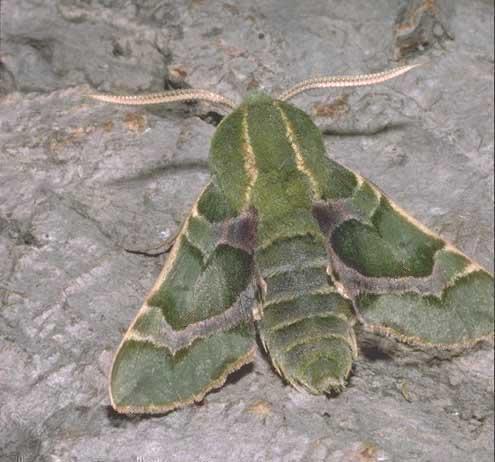
Arctonotus lucidus courtesy of T. W. Davies, enhanced by Dennis Haines.
This site has been created by
Bill Oehlke.
Comments, suggestions and/or additional information are welcomed by Bill.
TAXONOMY:
Family: Sphingidae, Latreille, 1802 |

This site has been created by
Bill Oehlke.
Comments, suggestions and/or additional information are welcomed by Bill.
TAXONOMY:
Family: Sphingidae, Latreille, 1802 |
This species has recently been assigned to the Proserpinus genus. VOLUME 63, NUMBER 4 233 Journal of the Lepidopteristsí Society 63(4), 2009, 233-235
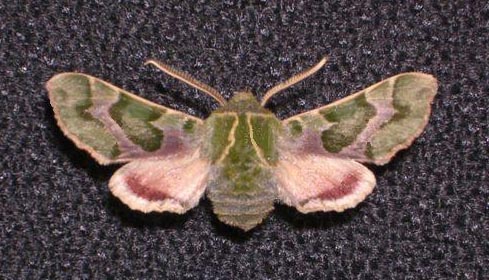
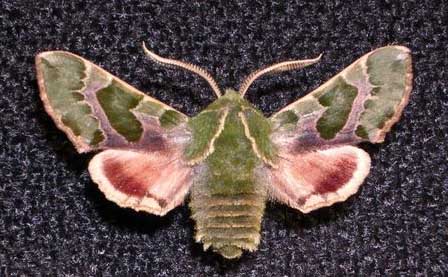
Arctonotus lucidus, male, Orange Cove, Tulare County, CA,
elev. 470', January 12, 2005, at lights, courtesy of Dennis Haines.
These moths have a short, stout body. The upperside of the forewing is green to olive green with pink and brown markings. The upperside of the hindwing is pale rose pink with a darker submarginal band.
Arctonotus clarki Barnes & Benjamin, 1923, Washington, is the same as Arctonotus lucidus.
Dave Wikle reports: "This little gem (just slightly northeast of center) came to blacklight with 3 buddies between 9:00pm and 9:45pm. These were found in the Cuyama Valley, Santa Barbara County, Ca., last night December 17, 2003. Temps 2 nights ago in upper 20's, following rains of 1/10" 3 days ago, last night upper 40's when they flew. Elevation 2570', South side of the valley, habitat is live oak and scrub grassland (ag+grazing) bordering the manzanita, cercocarpus, redshanks community 1/2 mile to the South." |
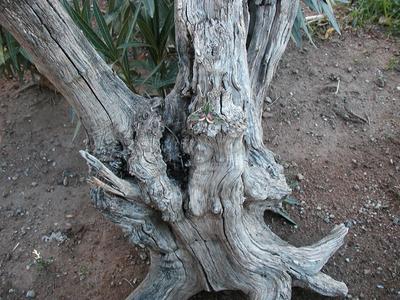 |
David Wikle reports taking a female at 6:30 pm, January 13, 2004, near San Diego at high elevation 3700 feet and temp of 59 F.
Patience Hervey reports them in Chico (Butte County), California, onDecember 29-30 at lights.
Edna Woodward reports a flight on January 16, 2010 in Wolf Creek, Josephine County in southwestern Oregon.
Matthew Campbell passes on the following observations in 2018: "This year offered unusually warm winter weather, which coincided with a very early flight in
Oregon. I was collecting specimens at lights on Feb 8-9 until the weather turned very cold again.
"This species is most attracted to blacklights. I use a 350nm fluorescent tube, and also an MV main. However, the MV is mostly used for me to be able to see
where they moths are if they aren't right by the light.
"Females are attracted to light, and I was able to collect two the first evening.
"On the first night, weather was very warm at around 52F at dusk. They didn't start flying until about 8:00pm after things cooled off a bit.
"The second night was cooler, maybe 37 degrees at dusk. They started flying immediately after dusk."
Visit Arctonotus lucidus, Wolf Creek, Josephine County, Oregon, February 1, 2010, air temperature at 35 F, courtesy of Edna Woodward.
Visit Arctonotus lucidus, Spokane, Washington, March, 2011, courtesy of Zana Goulding.
Visit Sherman County page for beautiful images submitted by Greg Volkman and Kathy Thompson.
Dave Wikle, Pasadena, California, writes, "News from the zoo: The first progeny of a 2004 female Arctonotus lucidus eclosed
on Tuesday Jan 25, 2005, or Monday night after dark.
It had been warm and dry since our monster rains of the first half of January 2005, and this eclosure was 24 hrs prior to the next rains
(as in it is raining right now in So Cal.)
"The gravid female was taken in San Diego Co. Jan 13, 2004 and oviposited for me a week later. I collected the pupae from the
rearing tub floor several weeks after pupation, and kept them indoors, non refrigerated, in a sealed tupperware container with a
dry paper towel in it to absorb excess moisture till December when I set them near an open window to be closer to outside temps.
(Arctonotus lucidus male, Dave Wikle.)
"At the onset of the late December rains, I moved the bulk of the pupae to a larger tub with 2" of moist/wet sand, and made small
impressions in the sand for each pupa, then covered with a layer of TP (unscented) and sprayed down with water.
"I kept about half a dozen in the original dry tupperware container inside near the window but moved the sanded pupae outside into the
torrential rains (having cut drainage slits in the plastic tub) about Jan 3.
"The inside dry pupae stayed compact but the wet ones immediately expanded to twice their size, waiting for the right time to eclose.
With this first eclosure and another rain, I have sprayed down the dry pupae and will move them outside this week to see if the 3 week
gap has any effect on eclosion time- as in will the two batches all eclose en masse." "It is a male, the green color even more emerald and brilliant than the ones taken in the field.
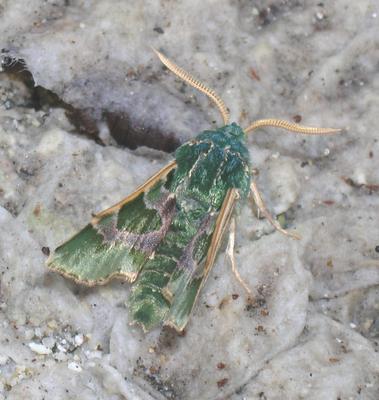
Larvae feed on evening primrose (Oenothera dentata var. campestris) and clarkias. David Wikle fed them on both Mexican evening primrose, Oenothera berlandieri and evening primrose, Oenothera biennis.To the right, tiny first instar larvae are feeding on a potted plant. | 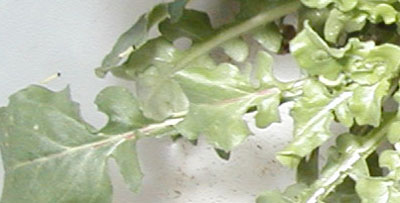 |
David reports: "From what I could garner, the first instar is yellowish with a black head, the second is green with a green head, the third stays green but gains a slight white side stripe, and the fourth is either dark colored (early on, it is an incredibly beautiful slate/cobalt mix on top) or else green, but with side spots," | 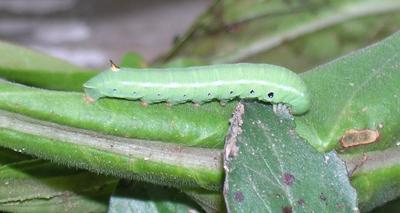 |
David continues, "and in the fifth, the 'eye of God' is pasted on its arse and the horn is replaced by a raised area like Xylophanes or Eumorpha larvae."All larval images are courtesy of David Wikle. | 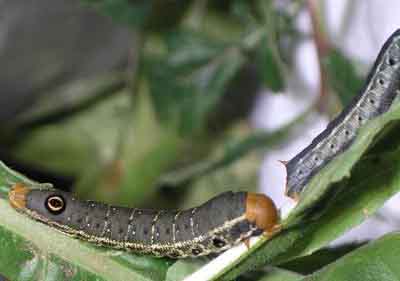 |
Paul Johnson sent me this image of what appears to be a fourth instar larva, 2 April, 2004 at Pinnacles National Monument, San Benito County, Caklifornia. He writes, "The image was taken first thing in the morning, so I think this was its overnight position. The Arctonotus is on Camissonia.
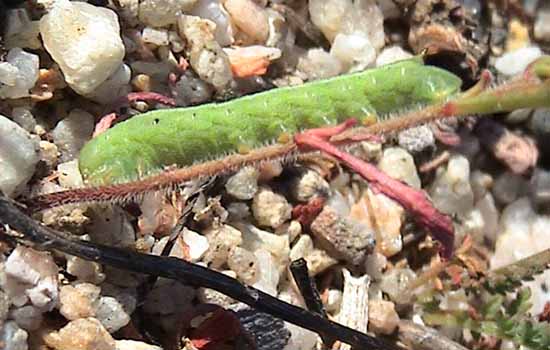
David Wikle was successful in getting this species to pupate.
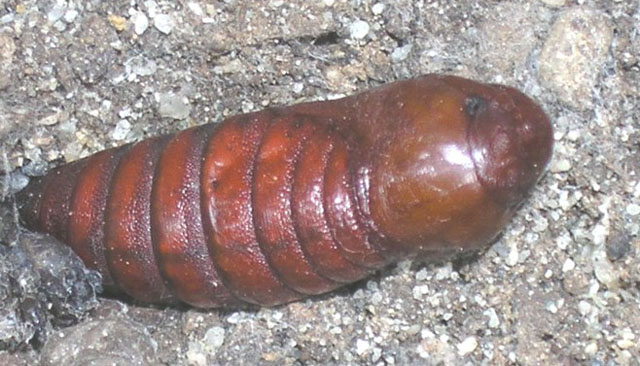
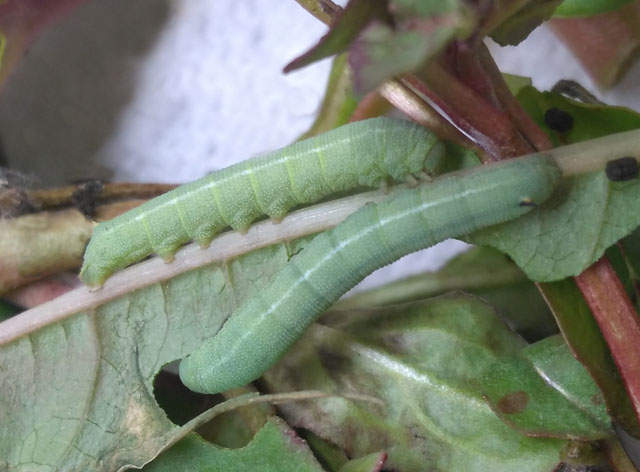
Proserpinus lucidus on fireweed, Oregon,
March 9, 2018, courtesy of Matthew Campbell.
The pronunciation of scientific names is troublesome for many. The "suggestion" at the top of the page is
merely a suggestion. It is based on commonly accepted English pronunciation of Greek names and/or some
fairly well accepted "rules" for latinized scientific names.
The suggested pronunciations, on this page and on other pages, are primarily put forward to assist those who hear with internal ears as they read.
There are many collectors from different countries whose intonations and accents would be different. Those species names which end in "ensis" indicate a
specimen locale, and those which end in "i", pronounced "eye", honour a contempory friend/collector/etc.
In Greek myth, "Arcto" means bear and "Notus" is the God of the South Wind which is warm, humid and quite balmy.
As a very early-spring flier along the west coast, the name for this genus may have been chosen to reflect the weather and the emergence of
bears from their hibernation. Recently this species was assigned to the Prosperinus genus.
The species name "lucidus" may have been chosen for the relative brightness of the hindwings. Use your browser "Back" button to return to the previous page.
Goto Main Sphingidae Index
Use your browser "Back" button to return to the previous page.
This page is brought to you by Bill Oehlke and the
WLSS. Pages are on space rented from Bizland. If you would like to become a "Patron of the Sphingidae Site", contact Bill.
Please send sightings/images to Bill. I will do my best to respond to requests for identification help.
Goto Macroglossini Tribe
Goto Central American Indices
Goto Carribean Islands
Goto South American Indices
Goto U.S.A. tables